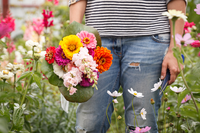
An advantage to owning a greenhouse is that you can grow something almost all year. A greenhouse can be used to look after your plants over winter or just for a little extra storage over the colder months, but what if you do want to extend the growing season all year round? Then you are most likely going to need to heat the greenhouse to help your plants along. Here are our top 6 tips for heating your greenhouse:
1. Electric and solar power
There are a few ways to heat your greenhouse to keep growing thought the cooler months of the year or to overwinter some plants. The best way to do this is to use a heater inside the greenhouse. Make sure you get the temperature right to look after your plants all year. There are many small electric heaters available, but you will need a supply direct to your site. Alternatively, why not try solar-powered heating to save on the need for electricity close to your greenhouse.
2. Bubble wrap packaging
Do you ever wonder what to do with all of the bubble wrap when you have received parcels or moved house? Save this up all year because if you need to insulate your greenhouse over Autumn and Winter, this can come in handy. Carefully secure the bubble wrap on the inside of your greenhouse, and that will help to keep your plants safe and warm.
3. Composting in the greenhouse
Did you know you can raise the temperature in your greenhouse by composting hay or straw inside? So if you have enough room, you could try composting a bake of hay because as it breaks down, it will give off some heat.
4. Cooling
In the hot summer, you will most likely need to cool the greenhouse to stop plants from wilting or even getting sun-scorched on sunny days. Use blinds or some shading to protect your plants and to lower the temperature. Another way of cooling is by spraying water on the floor of the greenhouse, which we call damping down. It's an excellent way to raise the humidity, which helps plants cope with the heat. So you may need to heat sometimes but don't forget to cool when required as well!
5. Ventilation
No matter what time of year you might need to keep an eye on ventilation especially in warmer weather. Ventilation helps your plants to limit the risk of pests and diseases and give good airflow. It's a good idea to open the door in the mornings and close it back up in the evening during the summer. Other ways to ventilate are to have louvres or even automatic ventilation to ensure things are kept in order even when you are not home.
6. Partition
If you only have one or two plants to stay warm, partition off that area with polythene, and that will create a little microclimate just for those plants.




